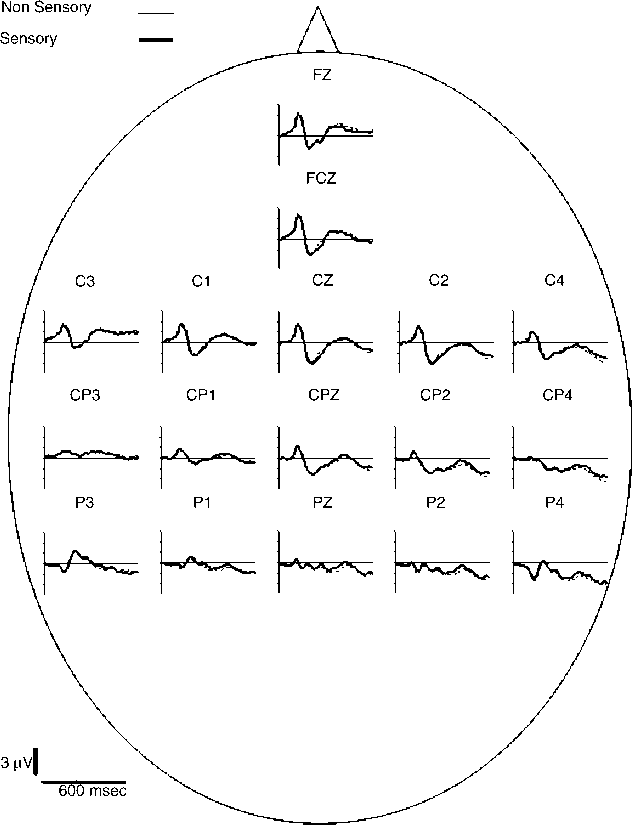142
G. Sartori et al. /Neuroscience Letters 390 (2005) 139-144

Fig. 2. Grand average ERPs in response to descriptions of Sensory and Non-sensory concepts. No difference in the N400 windows at any site.
[12], close to vertex. In accordance with the literature [12],
the N400 peak was defined as the negative deflection in the
time range between 300 and 500 ms after target onset.
A first ANOVA was performed on average voltage of the
time window 300-500 ms after target onset. Category (Living
versus Non-living), Relevance (High versus Low), Feature
Type (Sensory versus Non-sensory), Congruency (Yes versus
No) and Midline (FPZ, FZ, FCZ, CZ, CPZ, PZ, POZ, OZ)
were the within-subject factors. In this analysis we observed
a significant effect of the Midline factor (F(7,161) = 15.24;
p < 0.001) and, as reported in previous studies [11,12], the
maximum N400 effect (i.e. the difference in N400 ampli-
tude between congruent and incongruent targets [10]) was
detected in CZ, CPZ and PZ. Hence, we repeated the same
analysis using CZ, CPZ and PZ as levels of the Midline
factor, which was not significant (F(2,46) = 1.10; p= 0.34)
and did not interact with any other factor. The N400 did
not differ between Categories (F(1,23) = 1.76; p = 0.20) and,
except for the interaction with Feature Type, no other effect
involving Category was significant. More specifically, the
interaction between Category and Congruency was not sig-
nificant (F(1,23) = 2.89; p = 0.10). The N400 did not show
any significant difference (F(1,23) = 1.25; p = 0.28) between
Feature Type and, no other interaction with Feature Type was
significant. Particularly, interaction of Feature Type by Con-
gruency was not significant (F(1,23) = 0.46; p= 0.50). The
N400 to low relevance was larger than to high relevance
semantic features (F(1,23) = 29.81; p < 0.001). Given that the
N400 indexes semantic incongruity [12], the differing effect
to high and low relevance shows that low relevance descrip-
tions index with more difficulty the target concept and this
is consistent with previous behavioural observations.7 The
significant interaction between Relevance and Congruency
(F(1,23) = 9.04; p < 0.01) indicates that the N400 is larger for
7 Confronting concepts with their high relevance descriptions is accu-
rate and fast. In contrast, confronting concepts with their low relevance
descriptions is harder, yielding inaccurate and slow responses. The seman-
tic incongruity that gives rise to the N400 is therefore characteristic of low
relevance descriptions.
More intriguing information
1. CONSIDERATIONS CONCERNING THE ROLE OF ACCOUNTING AS INFORMATIONAL SYSTEM AND ASSISTANCE OF DECISION2. Quelles politiques de développement durable au Mali et à Madagascar ?
3. The name is absent
4. The name is absent
5. Does Presenting Patients’ BMI Increase Documentation of Obesity?
6. Update to a program for saving a model fit as a dataset
7. Who runs the IFIs?
8. The Dictator and the Parties A Study on Policy Co-operation in Mineral Economies
9. Cryothermal Energy Ablation Of Cardiac Arrhythmias 2005: State Of The Art
10. The name is absent